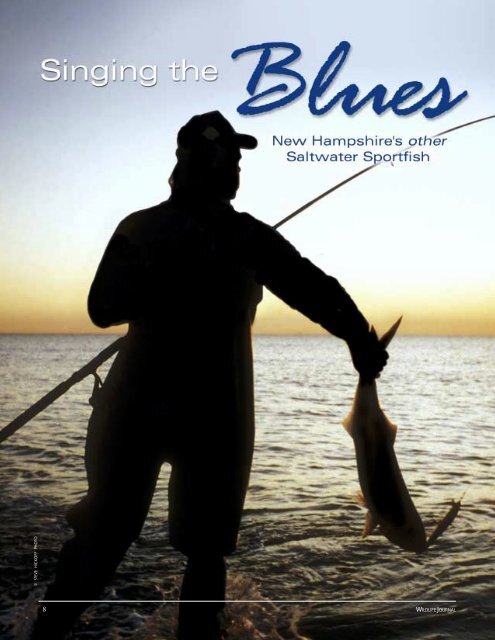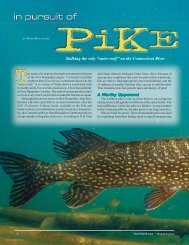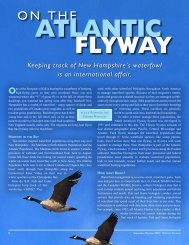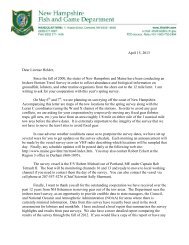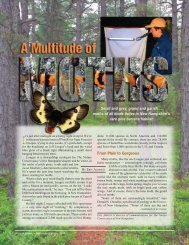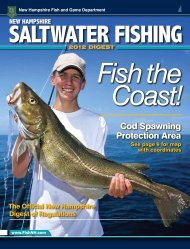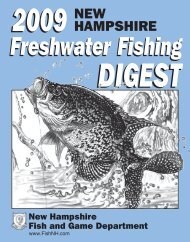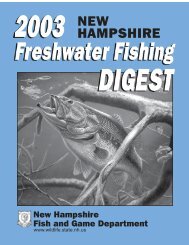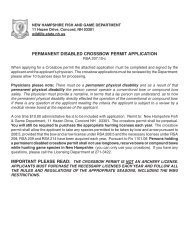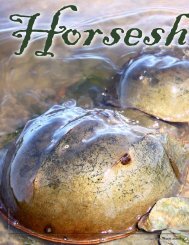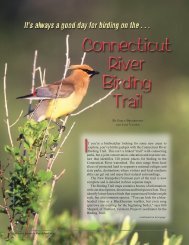Singing the Blues - New Hampshire Fish and Game Department
Singing the Blues - New Hampshire Fish and Game Department
Singing the Blues - New Hampshire Fish and Game Department
Create successful ePaper yourself
Turn your PDF publications into a flip-book with our unique Google optimized e-Paper software.
© STEVE HICKOFF PHOTO8 WILDLIFE JOURNAL
At daybreak, <strong>the</strong> deep, calm water just beyondsea-foam breakers on <strong>the</strong> Atlantic Ocean seemsmachine-gunned in bursts of activity. Roving<strong>and</strong> rushing at prey like hungry wolves, it’sschool-feeding bluefish—half teeth, half tail—in a coastal feeding frenzy.BY STEVE HICKOFFWhile striped bass get many a coastal Granite State angler’sattention, saltwater aficionados double <strong>the</strong> pleasure by targetingblues. The bluefish are out <strong>the</strong>re for saltwater anglers tofind, <strong>and</strong> <strong>the</strong> time is NOW. Want fishing excitement? You’vesurely got it with bluefish.Where, Oh Where?Great Bay. Little Bay. The Piscataqua River.Here, <strong>the</strong>re, most everywhere. . . .Along <strong>the</strong> Atlantic coastline <strong>and</strong> out to <strong>the</strong> Isles of Shoals—where baitfish go, bluefish follow. Find <strong>the</strong> baitfish, <strong>and</strong>you’re in business. It’s a matter of being out <strong>the</strong>re in <strong>the</strong> rightplace when <strong>the</strong> action commences—which can vary with <strong>the</strong>serestless fish.<strong>New</strong> <strong>Hampshire</strong> surfcasters can try coastal rivermouths <strong>and</strong>tidal creeks right at <strong>the</strong> turn of <strong>the</strong> incoming tide—preferablyat daybreak or during <strong>the</strong> false dawn, as bluefish seem to feedvoraciously right after <strong>the</strong> summer sun rises out over <strong>the</strong>offshore Shoals. Low-tide situations seem to enhance <strong>the</strong>blues’ wolfpack instinct to trap baitfish against exposed rockyledges <strong>and</strong> hard-s<strong>and</strong> beaches.Study <strong>the</strong> underwater structure <strong>and</strong> how <strong>the</strong> tide moves withit. In time, you’ll acquire an insider’s perspective to target<strong>the</strong>se restless, relentless predators.Like stripers, bluefish migrate north in <strong>the</strong> spring to <strong>the</strong>selocations. By summer <strong>the</strong>y lurk, feeding <strong>and</strong> moving inschools. Then both species head south for <strong>the</strong> winter, sharing<strong>the</strong> same coastal waters.Mackerel—a good cut bait for marauding bluefish—sometimeshold at <strong>the</strong> Piscataqua River mouth, or offshore, whereyou can catch <strong>the</strong>m by jigging, <strong>the</strong>n store <strong>the</strong>m in live wellsfor immediate fishing or freeze <strong>the</strong>m for future use. Sometimessmaller baitfish roam away from l<strong>and</strong>, or upriver into Little Bay<strong>and</strong> Great Bay. O<strong>the</strong>r times, baitfish activity is hard to comeby. You just have to keep at it—first to find baitfish; <strong>the</strong>n <strong>the</strong>blues. Using high-tech fishfinders, modern baitfish-seekinganglers might locate schools lurking on offshore humps. <strong>Blues</strong>could be nearby.Seasonal Piscataqua River anglers—flanked by <strong>the</strong> <strong>New</strong><strong>Hampshire</strong> <strong>and</strong> Maine shorelines—seek out humps, <strong>and</strong> put<strong>the</strong>ir bait down toward that bottom structure for stripers. Oftenblues will be right in <strong>the</strong>re with <strong>the</strong> mix, nailing a live offeringon its way down.By boat, anglers might find bluefish roving offshore by dayafter <strong>the</strong>ir early-morning feed, in waters beyond <strong>the</strong> rockhuggingstripers. You can chum <strong>the</strong> water <strong>and</strong> toss cut bait.continued on next pageWILDLIFEWILDLIFEJOURNALJOURNAL9
© ETHAN GORDON PHOTOWhen reeling in or h<strong>and</strong>linga bluefish, don’t let thoseneedle-sharp teeth anywherenear your fingers! Thissurface popper didn’t st<strong>and</strong> achance.You can cast big metal lures <strong>and</strong> even flies. In allhonesty, anglers who enjoy both stripers <strong>and</strong>blues relish <strong>the</strong> action both provide. Some boaterswho chum smelly concoctions into <strong>the</strong> sea toentice striped bass by day, wince at <strong>the</strong> appearanceof bluefish <strong>and</strong> <strong>the</strong> ubiquitous dogfish. Suchanglers might decide to cast big jigs into currents<strong>and</strong> let <strong>the</strong>m drift back for fast-action angling. Insuch cases, with oversized lures, wire leadersmight not even be needed as insurance against <strong>the</strong>sharp-too<strong>the</strong>d gamesters.Cast When You ou CanYou can catch <strong>the</strong>m as early as springtime, butmid-summer to <strong>the</strong> post-Labor Day Septemberperiod can be even better as blues go. Last year on<strong>the</strong> Seacoast, by mid-August, three- to four-poundblues were all over <strong>the</strong> fabled Great Bay fishery:<strong>the</strong> waters off Adam’s Point, locations near <strong>the</strong>Stratham railroad trestle, <strong>and</strong> so on. Small surfacelures seemed to be <strong>the</strong> trend on <strong>the</strong>se fish, usuallyat <strong>the</strong> end of incoming tides until <strong>the</strong> surge movedout again. As such phases go, watch for gullsworking baitfish schools. <strong>Blues</strong> should be <strong>the</strong>retoo.Elsewhere along <strong>the</strong> coastal shore last summer,Rye <strong>and</strong> Hampton party boats were reportingsuperb morning fishing for <strong>the</strong>ir clients. Sou<strong>the</strong>rnlocations, such as <strong>the</strong> Merrimack River on <strong>the</strong><strong>New</strong> <strong>Hampshire</strong> <strong>and</strong> Massachusetts border, heldbluefish blitzes at <strong>the</strong> rivermouth.I’ve caught bluefish as early as springtime on<strong>the</strong>ir return to our coastline, but <strong>the</strong> shore fishingof late August into September is unrivaled—<strong>and</strong>what we <strong>New</strong> Engl<strong>and</strong> surfcasters wait for. By lateAugust last year, shoreline feeding frenzies increasedas saltwater fish—both blues <strong>and</strong>stripers—began <strong>the</strong>ir sou<strong>the</strong>rn migration. In suchsituations, <strong>the</strong> predatory sportfish push schools ofbaitfish right up into <strong>the</strong> shallows. Enterprisinganglers greet <strong>the</strong>m.Edge of <strong>the</strong> MayhemOften this time of <strong>the</strong> year brings late-summerstorms. The rough wea<strong>the</strong>r changes water coloralong <strong>the</strong> shoreline. <strong>Blues</strong> (<strong>and</strong> stripers) begin tolinger in discolored currents along <strong>the</strong> coast, as ifutilizing <strong>the</strong> murky water to hide. Onshore winds—into which we cast—push warmer water toward us.Baitfish follow.With <strong>the</strong>se onshore winds moving warm watertoward <strong>the</strong> beachfront, colder water replaces itoffshore. This may account for why big fish moveinshore, too. The beauty of it for <strong>the</strong> boatlesssurfcaster is that <strong>the</strong> roving fish that were targetedall summer by watercraft anglers are now just a castaway.As a result, a great time to nail blues from shoreis September, <strong>and</strong> even into early October. After10 WILDLIFE JOURNAL
Labor Day, beach anglers can roam <strong>the</strong> coastline,watching for schools of blues <strong>and</strong> stripers. A goodpair of binoculars helps, if you like to scout fromyour vehicle in “run-<strong>and</strong>-fish” mode. You canalso just watch for gulls hovering above <strong>the</strong> frenzy.Move fast, though, <strong>and</strong> keep your gear at <strong>the</strong>ready. Once <strong>the</strong>re, fish <strong>the</strong> edges of <strong>the</strong> mass ofsportfish <strong>and</strong> baitfish. Back when I was learningthis game, I’d cast right in <strong>the</strong> middle of it, <strong>and</strong>sometimes spook <strong>the</strong> entire school.Boaters can work <strong>the</strong> edges of this mayhem <strong>the</strong>same way.Know too, that while we are talking blues here,stripers will be in <strong>the</strong> mix—often beneath <strong>the</strong>roving blues, chowing on <strong>the</strong> falling bits of bluefish-chompedbaitfish. So, if you just want blues,fish with topwater plugs <strong>and</strong> retrieve <strong>the</strong>m fast.Consider wire leaders to avoid cut-offs—or not.Classic Rapala offerings still work. If you want amixed-bag of stripers, too, fish fast-sinking luresor weighted baits. It’s all good.Fly <strong>Fish</strong>ing for Fanatics“Are you crazy? Bluefish on flies?!”Fly-fishing rods <strong>and</strong> reels need to be matchedfor durability <strong>and</strong> balance, as casting to bluesmust be done quick-off-<strong>the</strong>-mark when blitzes arespotted, <strong>and</strong> once <strong>the</strong> fish is on, your tackle willbe tested.Weight-forward lines will let you cast into <strong>the</strong>teeth of an onshore wind. Presentations aren’tnearly as delicate as freshwater offerings on smalltrout streams. Want to fish on top? <strong>Fish</strong> poppingbugs on floating lines. Sinking tips can be used onbaitfish-mimicking patterns. True sinking linescan work for blues (but more likely stripers), <strong>and</strong>force you to tote many options in your sagging flyvest.Where reels are concerned, backing rules—lots of it. A football field of it will do. <strong>Blues</strong> loveto run <strong>and</strong> muscle you during <strong>the</strong> ensuing fight,<strong>and</strong> you have to be ready.continued on next pageGluttonous blues willbite at almostanything when<strong>the</strong>y’re in a feedingfrenzy. Some lures totry (from left): big jigwith attractor/spinner; floatingminnow bait toimitate local foragefish or baitfish;crankbait, pogiestyle.Length: 39 inchesWeight: 21 poundsWhen: August 23, 1975Where: Great Bay, DurhamAngler: Henry KrookA.K.A.Tailer, slammer, chopper●●●●●Live eelsMackerel (chunks)Pogies (menhaden)SquidHerringBluefish sport a nasty setof needle-sharp teeth. Wireleaders are an important part of<strong>the</strong> angler’s arsenal.The Atlantic silverside is one ofseveral species of schooling fish that<strong>the</strong> bluefish targets for a feeding frenzy.© VICTOR YOUNG ILLUSTRATIONSWILDLIFE JOURNAL 11
<strong>Fish</strong>ing for bluesfrom shore is best inSeptember <strong>and</strong> eveninto early October.Get out early <strong>and</strong>cast often.© NHF&G PHOTORods can range from 8 1 /2- to9-foot offerings paired with 8-Finding Baitweight line to 9- or 9 1 /2-foot surfTwo places along <strong>the</strong> N.H. seacoast provide live bait with reliability: sticks matched with 9- to 10-Suds-n-Soda in Greenl<strong>and</strong> (603-431-6320), <strong>and</strong> Taylor’s Trading Postweight line.in Madbury (603-742-5931).My basement <strong>and</strong> closet areAs <strong>the</strong> season wanes, bait becomes tougher to find. Some coastalfull of a range of fly rods, manyanglers freeze <strong>the</strong>irs as mid-September arrives, attempting to extendcoastline angling into October.of <strong>the</strong> old-school type; some—S.H.that I’ve used for three decades(seriously). Sea-lashed tackletakes a beating, <strong>and</strong> I try toscour gear with soapy suds aftereach trip to <strong>the</strong> coastline. Dothat, <strong>and</strong> your gear—fly tackleor spinning—will last longer.Bluefish tend to strike from<strong>the</strong> rear, accounting for why youcan catch <strong>the</strong>m on flies—often after <strong>the</strong>y’ve repeatedlynipped at your offering. Apply tensionwhen you feel it on <strong>the</strong> o<strong>the</strong>r end. Sometimes,yeah, <strong>the</strong>y’ll part with your pattern, <strong>the</strong>ir teethslicing away at <strong>the</strong> fly.Wire shock tippets (say three or four incheslong) can offer insurance, but can hinder casting.Baitfish along <strong>the</strong> <strong>New</strong> <strong>Hampshire</strong> coastlinerange from silversides to s<strong>and</strong> eels, as well asherring <strong>and</strong> menhaden. Fly anglers (<strong>and</strong> indeedlure casters) can try to match <strong>the</strong>se based on size<strong>and</strong> color estimates, along with a good sense ofavailable patterns out <strong>the</strong>re, of which <strong>the</strong>re aremany.The Blitz Is OnStripers run big, fight hard. A bluefish doesboth, including some breathtaking tailwalking<strong>and</strong> jumping that’s unrivaled in this part of <strong>the</strong>world. Some guys, I swear, claim boated or beachedblues intentionally size <strong>the</strong>m up, <strong>and</strong> bite <strong>the</strong>mwith <strong>the</strong> intent to inflict harm. Mythmaking ornot, blues don’t take it sitting down.How do you recognize that <strong>the</strong> blitz is on? Youmay first notice a sweet watermelon smell —familiar to all saltwater anglers — that indicatesbaitfish are nearby <strong>and</strong> being targeted by predatoryfish. Visual evidence <strong>the</strong>n appears: a blue ortwo may sweep by <strong>the</strong> boat, or a mob of <strong>the</strong>m mayappear near a breakwater or ledge, hammering <strong>the</strong>smaller baitfish in question.Friends, bluefish tend to get your anglingblood up just a little. Get out <strong>the</strong>re <strong>and</strong> enjoy it.© ETHAN GORDON PHOTOA longtime N.H. Wildlife Journal contributor,Foster’s Sunday Citizen newspaper columnist,outdoor photographer <strong>and</strong> flyfishing bookauthor, Steve Hickoff (hickoff@comcast.net)makes his home in Kittery, Maine.12 WILDLIFE JOURNAL


